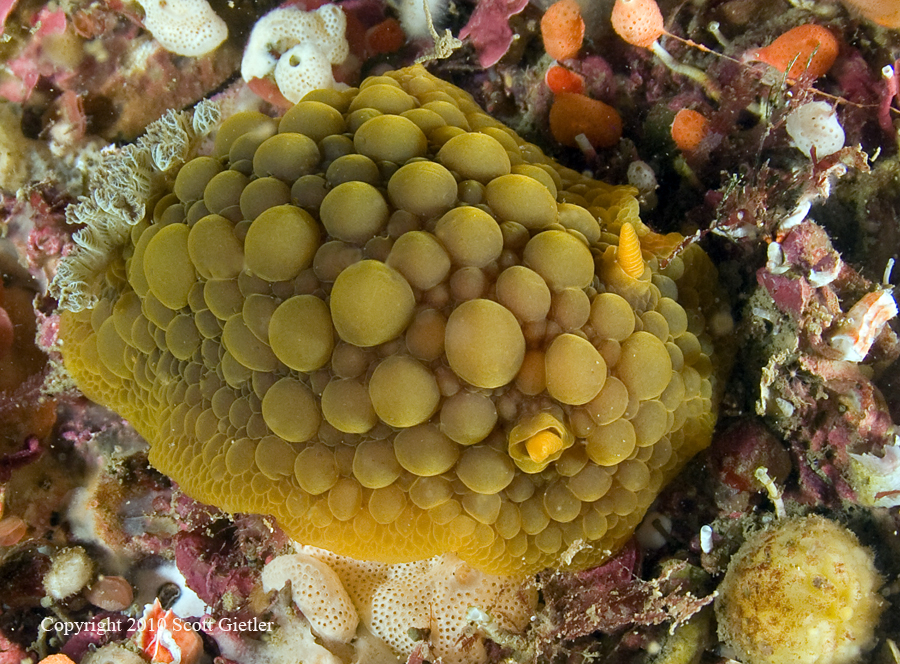 |
Doris wellingtonensis
Image courtesy of Scott GietlerPhotographed in the cold, rarely dove waters of Milford Sound on the south island of New Zealand with my D300 and Tokina 10-17mm wide-angle
This icy water species is likely the largest species in New Zealand, measuring up to 200 mm in length. The notum is covered with close-set round, flattened tubercles, the largest of which are concentrated mid-dorsally.
Extremely common throughout its geographical range the species is found throughout New Zealand, Tasmania and Victoria, from intertidal to about 20m.
Good job Scott , but it makes me shiver looking at it.
Gig Harbor, Washington
Jan., 2010
Scott Gietler
 |
Last month my wife and I went on an epic adventure to Australia and New Zealand for hiking and outdoor activities. My wife and I planned a trip to New Zealand last year, after seeing great prices on airfare with Quantas. The planes stopped in Sydney or Brisbane, so for a little more money we could get a stopover. After looking into Sydney and Brisbane, I realized you don't see any wildlife there (except for wildlife parks, which don't interest me), but you do near Adelaide on Kangaroo island. So for a little more money we decided to go to Adelaide for 4 days, which then grew to 8 days. Adelaide is in south central australia, 700 miles west of Sydney by plane. Then I learned that the Leafy Sea Dragon habitat is near Adelaide. Wow, Leafy sea dragons! One of the most beautiful fish in the world. This wasn't a diving trip, but I decided to bring my camera housing and strobe in case I got a chance to do a dive looking for a Leafy Sea Dragon. We decided to spend 2 days doing 6 dives looking for the elusive Leafy Sea dragon, and spend the rest of the time on Kangaroo island. That turned out to be a good decision, because there wasn't much else around Adelaide that interested us besides the Leafies. We dove 3 jetties near Adelaide. Wow, the diving was nice! A large diversity of fish, lots of colorful inverts and even quite a few nudibranchs. This was shore diving at it's finest. You could spend hours exploring these piers, doing macro or wide-angle photography. Parking, entry and exit were all easy. All you needed was a full tank. The fish was a mix of temperate and tropical, more tropical than I expected, with some boxfish, filefish, etc. Water temps were 66, vis 20-30ft, depths 20-40ft. We ended up finding 3 leafy sea dragons on 2 different dives. I found one on my own, and Penny found one on her own. The owner of a local dive shop accompanied us, and he also found one. One leafy was a large male with eggs, what a sight! You could spend hours just starting at these wonderful fish. One one dive, I also saw octopus mating for the 1st time. I mean really mating, right in front of me - it was quite a sight! The camouflage on these fish is amazing. They are large too, over 12 inches. |
Our days on Kangaroo island were fantastic. It was everything I had hoped for, and more. Unspoiled nature. hardly any people. We spend every day in the wild with kangaroos, koalas, wallabies, echidnas, possum, parrots, cockatoos, large lizards - finding them, watching behavior, and taking photos. We also spent time with fur seals and sea lions. Wildlife was the focus, with a little bit of nature/landscape photography thrown in for good measure. Finding wildlife in Australia outside of Kangaroo island is very difficult, because it is so spread out. Kangaroo island is 100 miles long, 30 miles wide and has no natural predators, so the wildlife flourishes there.
The echidna was the most difficult subject to photograph. They are elusive, egg-laying mammals that resemble a porcupine and move slowly. You'd think photographing them was easy, but no - almost impossible, because if you take one step they feel it, and stick their head in the ground. Only on my 6th and last echidna did I understand their behavior enough to photograph their behavior in their presence.
I will be writing up a logistics page for Australia - where to stay, when to go, costs, etc - so stay tuned.
here's my article and photos on the
Leafy Sea Dragon :
www.uwphotographyguide.com/leafy-sea-dragon
Send Scott email at sgietler@yahoo.com
or visit his site on
underwater photography , www.uwphotographyguide.com
